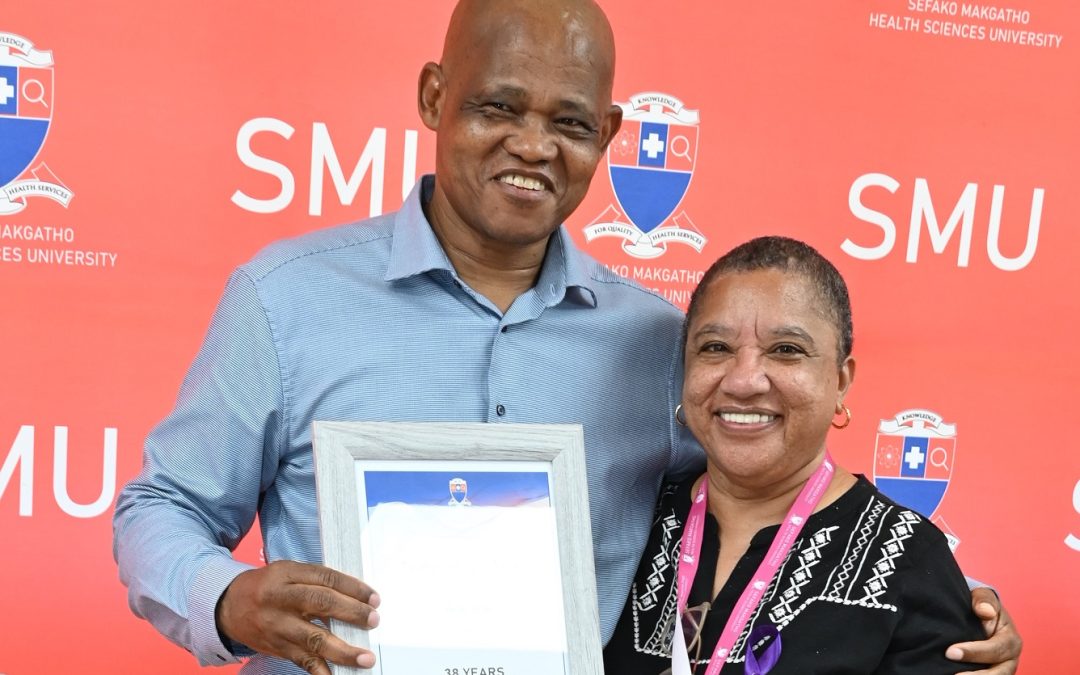
by Lorato | Dec 12, 2025 | All News, Alumni, SMU Media, Student Media
Jacob Monedi Lekabe’s distinguished journey from the humble streets of Thlabane Township, Rustenburg, to becoming a pillar of medical science and labour leadership at Sefako Makgatho Health Sciences University (SMU) epitomises dedication, intellectual rigour, and unwavering commitment to service. Reflecting on his early years, he recalls, “I grew up understanding the value of hard work and perseverance. My high school years at Rauwane Sepeng shaped my discipline and determination, and matriculating in 1979 was just the start of a lifelong journey of learning and service.”
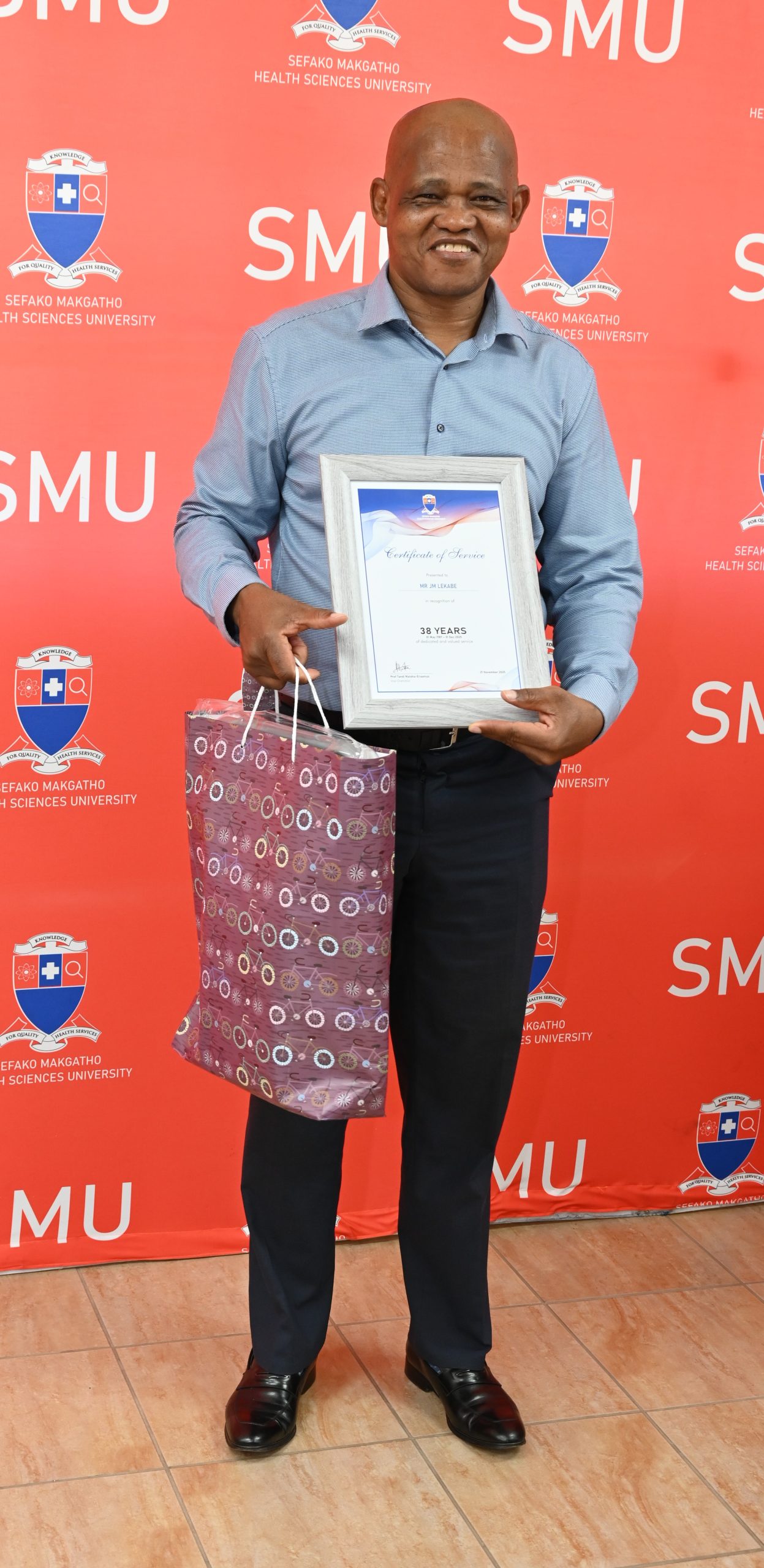 His professional odyssey began in earnest in May 1987 when he joined the then Medical University of South Africa (Medunsa) as a Medical Technologist in the Department of Haematological Pathology. Prior to this appointment, he trained extensively in Clinical Pathology, Microbiology, and Immunology—foundational expertise that would define his contributions to medical science over the next four decades. “Joining Medunsa was a dream come true,” he says. “The University gave me opportunities to grow professionally and academically, which I could not have imagined at the time.”
His professional odyssey began in earnest in May 1987 when he joined the then Medical University of South Africa (Medunsa) as a Medical Technologist in the Department of Haematological Pathology. Prior to this appointment, he trained extensively in Clinical Pathology, Microbiology, and Immunology—foundational expertise that would define his contributions to medical science over the next four decades. “Joining Medunsa was a dream come true,” he says. “The University gave me opportunities to grow professionally and academically, which I could not have imagined at the time.”
Over nearly forty years, Lekabe has cultivated a reputation for scientific excellence, mentorship, and leadership. Balancing full-time work with advanced studies, he completed his Bachelor of Science in 1994 and later a BSc Honours in Medical Sciences, specialising in Haematological Pathology, in 2012. “These academic milestones were crucial in enhancing my ability to contribute effectively to both clinical work and research,” he reflects.
One of the defining chapters of his career was his integral role in SMU’s Kidney Transplant Programme, where he performed Human Leucocyte Antigen (HLA) testing, immunological assessments, and related research between 1985 and 2005. “It was an intense and rewarding period,” Lekabe notes. “Knowing that our work directly influenced patient outcomes—and in many cases offered a renewed chance at life—was profoundly fulfilling.”
Beyond his scientific contributions, Lekabe has been an extraordinary mentor, guiding Intern Medical Scientists, Registrars, and BSc Honours students, particularly in quality assurance in medical laboratories. “Training the next generation of medical scientists was always close to my heart,” he says. “Seeing students grow in confidence and competence, and eventually become leaders themselves, is one of the most rewarding aspects of my career.”
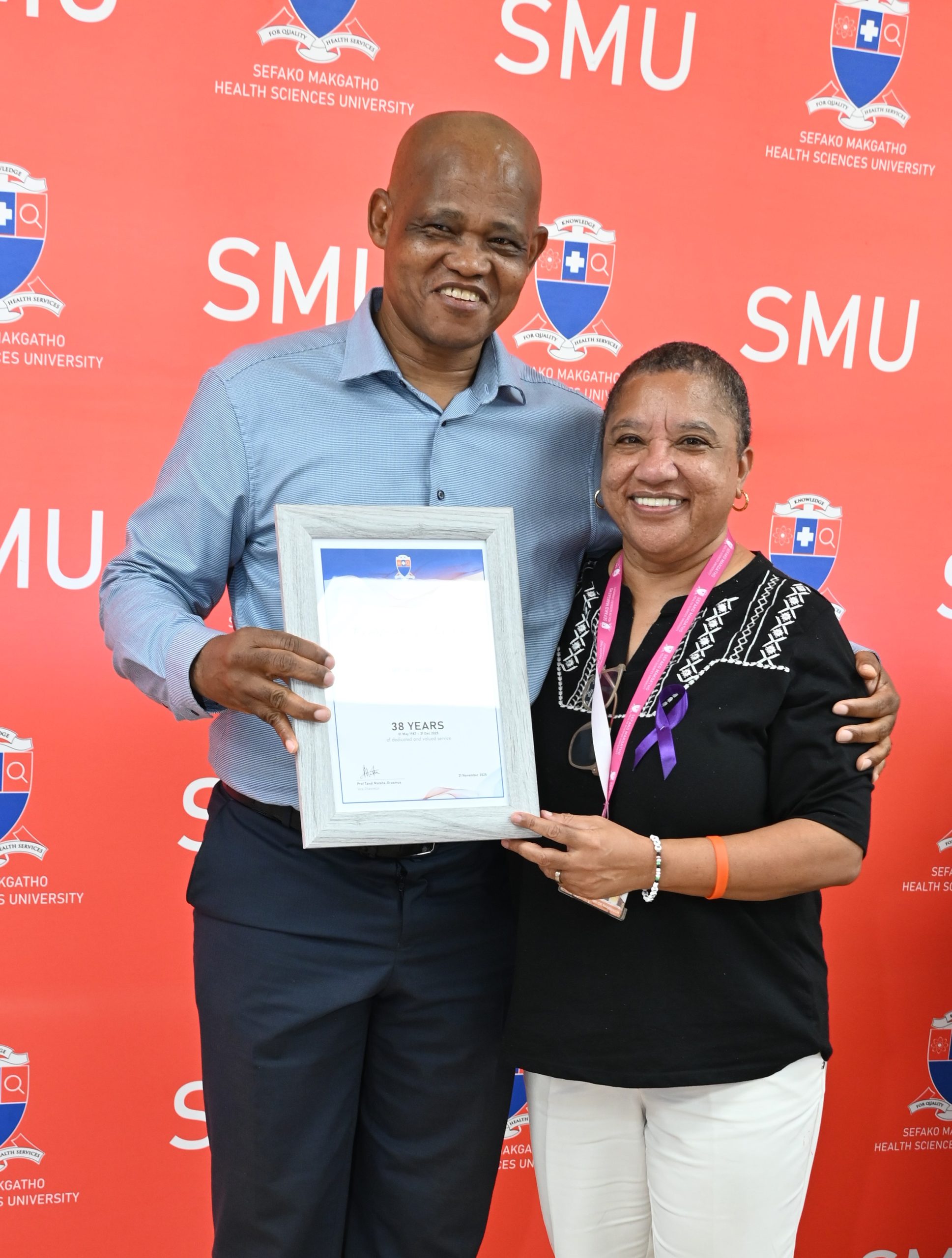 Parallel to his scientific and academic work, Lekabe has been a respected figure in labour leadership. Encouraged by Prof Vanessa Moodley, he actively participated in union matters and was appointed Chairperson of the South African Parastatal and Tertiary Institutions Union (SAPTU) in 2015, a role he continues to fulfil with distinction. “Being a union leader taught me the importance of dialogue, fairness, and collective responsibility,” he reflects.
Parallel to his scientific and academic work, Lekabe has been a respected figure in labour leadership. Encouraged by Prof Vanessa Moodley, he actively participated in union matters and was appointed Chairperson of the South African Parastatal and Tertiary Institutions Union (SAPTU) in 2015, a role he continues to fulfil with distinction. “Being a union leader taught me the importance of dialogue, fairness, and collective responsibility,” he reflects.
As SMU honours his retirement, Odette Ramsingh, Acting Deputy Vice-Chancellor: Operations, paid tribute during the retirees’ celebration: “Mr Lekabe represents the very essence of dedicated, principled service. His integrity, calm leadership, and unwavering commitment to excellence have left an indelible imprint on SMU. We celebrate not only his decades of work, but the dignity and mentorship he has exemplified throughout his career.”
Looking back, Lekabe expresses profound gratitude for the institutions that shaped him—Medunsa, the University of Limpopo, and now SMU. “It has been nearly forty years of service, learning, and giving back,” he says. “I am grateful for every opportunity, every challenge, and every success. These experiences have shaped me not just as a professional, but as a person committed to making a meaningful difference.”
Lekabe’s legacy—anchored in scholarship, mentorship, and principled leadership—will continue to inspire colleagues, students, and the broader SMU community.
By Dimakatso Modise
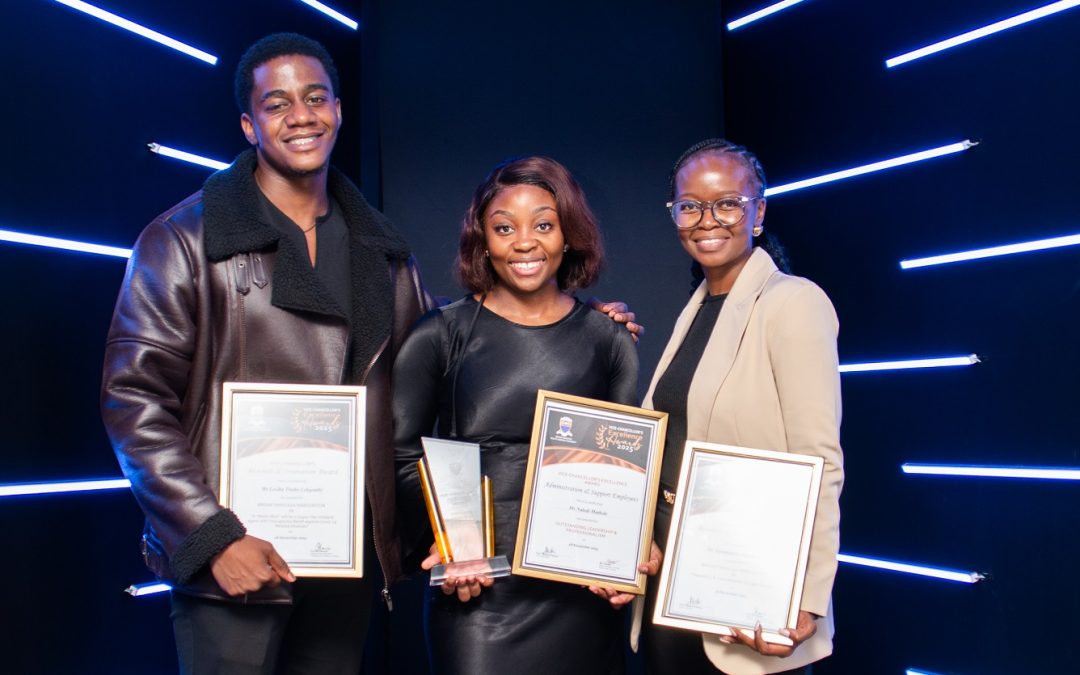
by Lorato | Dec 11, 2025 | All News, SMU Media, Student Media
Sefako Makgatho Health Sciences University (SMU) hosted its prestigious 2025 Vice-Chancellor’s Excellence Awards at the Protea Hotel Fire & Ice! Menlyn, celebrating employees whose commitment, leadership and innovation continue to strengthen the University’s core mission. Held under the theme “Advancing the boundaries of knowledge: Excellence for Impact and Sustainability,” the ceremony brought together academic leaders, administrative and support staff, and external partners to honour individuals shaping the future of the institution.
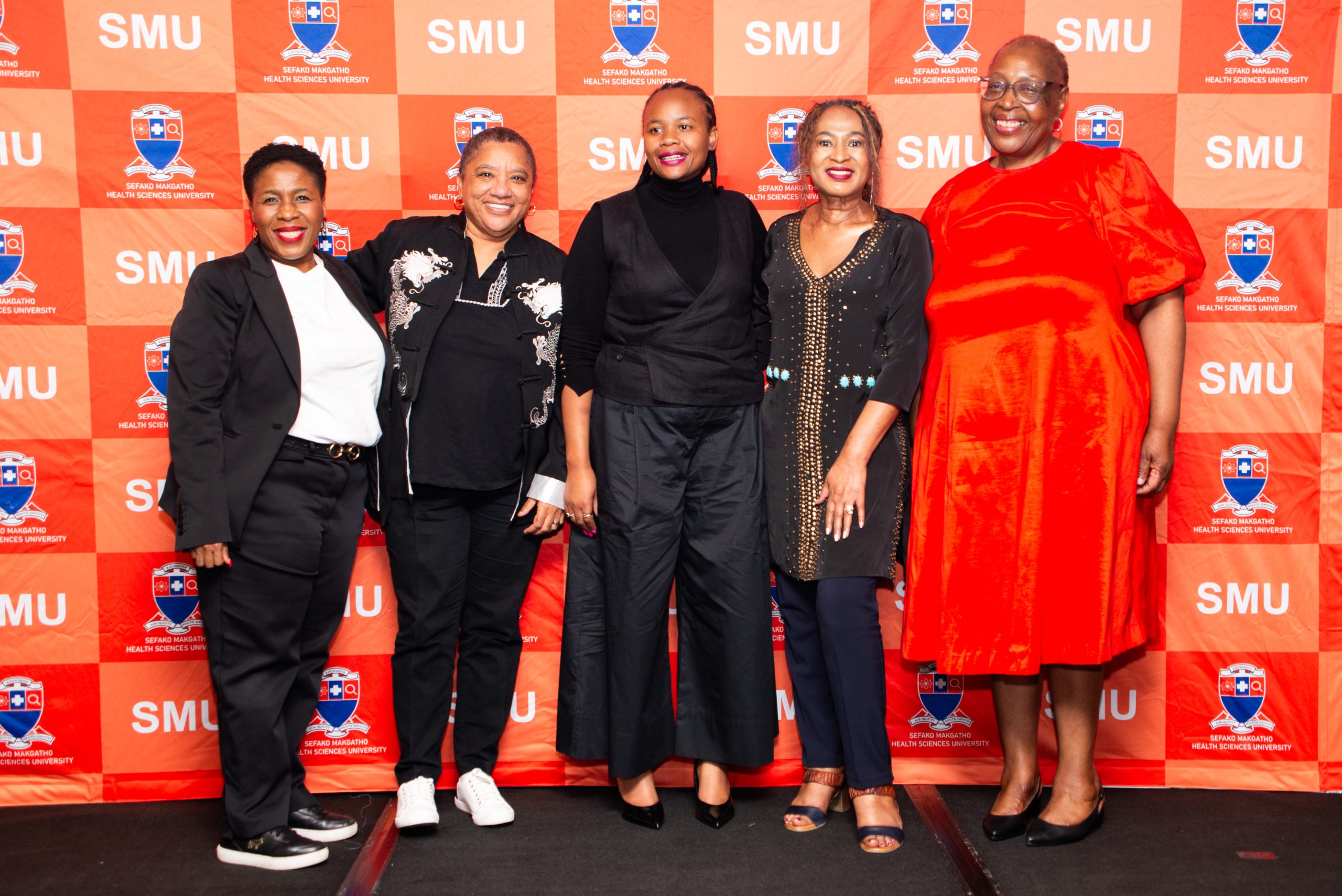 Delivering her opening address, the Vice-Chancellor, Professor Tandi Matsha-Erasmus, emphasised that excellence is a defining trait of SMU’s evolving identity. “Excellence at SMU is not a destination; it is a culture we build together,” she said. “Every staff member honoured tonight represents our commitment to transforming lives through education, research and service. Their contributions are the backbone of the University’s progress and our impact on society.”
Delivering her opening address, the Vice-Chancellor, Professor Tandi Matsha-Erasmus, emphasised that excellence is a defining trait of SMU’s evolving identity. “Excellence at SMU is not a destination; it is a culture we build together,” she said. “Every staff member honoured tonight represents our commitment to transforming lives through education, research and service. Their contributions are the backbone of the University’s progress and our impact on society.”
Professor Matsha-Erasmus also highlighted the importance of service-driven leadership in a health sciences institution. “Our work must consistently reflect compassion, accountability and innovation. These award recipients remind us what it means to serve humanity with purpose.”
Dr Nasiphi Moya, the Executive Mayor of the City of Tshwane, a scholar and public policy practitioner, delivered the keynote address. Reflecting on her journey from student activism to municipal leadership, she encouraged staff to position excellence as a daily discipline. “Excellence requires courage,” she told the audience. “It is the willingness to refine your craft even when no one is applauding. Institutions like SMU thrive because individuals choose to show up, do the work and inspire progress.” Dr Moya further commended the University for nurturing a workforce committed to national development. “SMU is not only producing future health professionals; it is cultivating principled leaders who will shape our healthcare system and communities.”
The evening’s honours included awards in administrative support, teaching and learning, leadership, client service and innovation. Among the recipients was Naledi Mathole, Coordinator of the Economic Activation Office, who received the Award for Outstanding Leadership and Professionalism. Under her stewardship, the SMU Enactus team won national recognition for social innovation.
 Reflecting on the accolade, Mathole said: “This award is deeply meaningful. Leadership is about service, collaboration and believing in the potential of others. I am grateful to work in an environment where ideas are supported, and innovation is encouraged.” She added that the recognition belongs to her entire team.
Reflecting on the accolade, Mathole said: “This award is deeply meaningful. Leadership is about service, collaboration and believing in the potential of others. I am grateful to work in an environment where ideas are supported, and innovation is encouraged.” She added that the recognition belongs to her entire team.
“No one succeeds alone. My colleagues and students are the reason our projects thrive. Together, we are proving that SMU can be a leading driver of community-focused innovation.”
Other recipients included Maria Baloyi, honoured for exceptional client service in the School of Medicine; Justice Maleba, celebrated for teamwork in Grounds Maintenance; and Bathabile Ndlovu, recognised for advancing sustainable landscaping and environmental stewardship on campus. Several academic staff members were also acknowledged for teaching excellence, curriculum innovation and research contributions.
As the night progressed, applause echoed through the venue as citations highlighted personal stories of resilience, integrity and passion. Many recipients were described as individuals who “go beyond the call of duty” and “embody the spirit of Ubuntu that defines SMU’s ethos.”
In her closing remarks, Prof Matsha-Erasmus reaffirmed the University’s determination to strengthen its culture of excellence. “Tonight reminds us that excellence is not a privilege for a few but a responsibility shared by all of us,” she said. “The individuals we honoured demonstrate that dedication, empathy and creativity can transform not only our institution but the communities we serve. Their achievements encourage us to push boundaries and pursue knowledge that improves lives.”
She also extended appreciation to the Mayor and partners who continue to support the University’s vision. “Collaboration with government, industry and communities strengthens our impact. We value the City of Tshwane’s continued engagement and commitment to developing a healthier, more knowledgeable society.”
The 2025 Vice-Chancellor’s Excellence Awards concluded with a renewed sense of pride and unity, celebrating the individuals whose work continues to elevate SMU’s standing as a leading health sciences institution. Through their service and innovation, the University moves closer to its goal of transforming healthcare, advancing knowledge and inspiring future generations.
Dimakatso Modise

by Lorato | Nov 27, 2025 | Accolades and Achievements, All News, Alumni, SMU Media, Student Media
Sefako Makgatho Health Sciences University (SMU) proudly celebrates the recent recognition of its newly appointed Council member, Dr Nomonde Mabuya, who has been awarded the prestigious Ellen Kuzwayo Council Medal by the University of Johannesburg for her outstanding contribution to public health, occupational safety, and women’s empowerment.
 A medical doctor, occupational health specialist, academic, business leader, and social innovator, Mabuya has dedicated more than three decades to advancing the wellbeing of South Africans. Her distinguished career aligns strongly with SMU’s mission to cultivate leaders who drive transformation and improve the quality of life across the country.
A medical doctor, occupational health specialist, academic, business leader, and social innovator, Mabuya has dedicated more than three decades to advancing the wellbeing of South Africans. Her distinguished career aligns strongly with SMU’s mission to cultivate leaders who drive transformation and improve the quality of life across the country.
For over thirty years, Mabuya has been one of the country’s leading advocates for workplace health and safety. She has advised major institutions—including Vodacom, Deloitte, Standard Bank, Telkom, and the South African Reserve Bank—on employee wellness and occupational health programmes that have protected thousands of workers and significantly improved working conditions across sectors.
Her influence has been especially notable in the mining industry. Mabuya played a central role in developing South Africa’s fitness-for-work guidelines, adopted by the Department of Mineral Resources and Energy in 2014. These guidelines continue to serve as a national benchmark for fairness, accountability, and improved protection for vulnerable mineworkers.
 As CEO of Qalo DigiHealth, she is advancing healthcare accessibility through digital innovation, promoting the use of electronic health records, remote patient monitoring, and other technologies that make healthcare more effective, affordable, and responsive to patients’ needs.
As CEO of Qalo DigiHealth, she is advancing healthcare accessibility through digital innovation, promoting the use of electronic health records, remote patient monitoring, and other technologies that make healthcare more effective, affordable, and responsive to patients’ needs.
Mabuya’s contributions also extend to education and social development. Having lectured for 15 years at the University of Pretoria’s School of Public Health, she has shaped generations of health professionals. Her founding of the Women’s Sports Trust and Women Entrepreneurs Trust further demonstrates her commitment to empowerment, providing mentorship, scholarships, and funding opportunities for women and girls across the country.
Her medico-legal expertise has been equally influential through her work with the Road Accident Fund and her leadership as Chair of the HPCSA RAF Tribunal Committee, strengthening justice and fairness in medico-legal assessments.
The University of Johannesburg’s Ellen Kuzwayo Council Medal recognises leaders who advance social equity, transformation, and national development, qualities that Mabuya exemplifies. Her appointment to the SMU Council brings a powerful combination of strategic insight, public health expertise, and a deep commitment to societal impact.
Mabuya’s leadership continues to shape healthier, safer, and more equitable communities, an inspiring alignment with SMU’s vision of excellence and service to society.
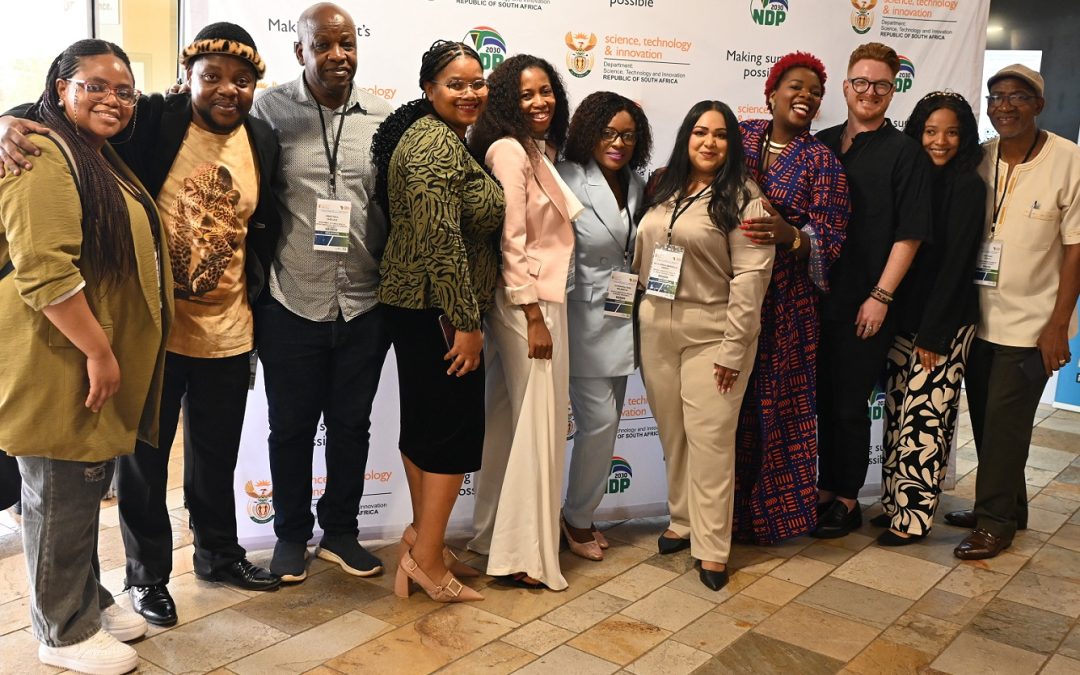
by Lorato | Nov 27, 2025 | All News, SMU Media, Student Media
A powerful conversation about the future of Indigenous Knowledge Systems (IKS) and emerging technologies took centre stage at the Science Forum South Africa (SFSA) 2025. As the discussions unfolded, Sefako Makgatho Health Sciences University (SMU) emerged as a key contributor, shaping national dialogue through a compelling, solutions-focused panel. One of the standout sessions of the forum was “Rooted in Resilience: Integrating Indigenous Plant Knowledge and Emerging Technologies for Health, Climate, and Community Wellbeing,” conceptualised and coordinated by Dr Clarissa Marcelle Naidoo, Senior Lecturer in the Department of Biology and Environmental Sciences, School of Science and Technology at SMU.
 Dr Naidoo, who opened and led the session, emphasised the need to bridge traditional wisdom with modern scientific innovation. “Our aim was to create a space where Indigenous Knowledge Systems are not only acknowledged, but actively integrated with emerging technologies in ways that benefit health, climate resilience, and community wellbeing,” she said. “This conversation is essential for South Africa’s scientific future, and SMU is proud to help drive it.”
Dr Naidoo, who opened and led the session, emphasised the need to bridge traditional wisdom with modern scientific innovation. “Our aim was to create a space where Indigenous Knowledge Systems are not only acknowledged, but actively integrated with emerging technologies in ways that benefit health, climate resilience, and community wellbeing,” she said. “This conversation is essential for South Africa’s scientific future, and SMU is proud to help drive it.”
The panel attracted significant engagement from attendees across academia, industry, and government. Guest speakers included Dr Phuti Chelopo-Mgobozi from The Innovation Hub; Mr Peter Gardner from Mint Group; Ms Karen Swanepoel from the Southern African Essential Oils Producers Association (SAEOPA); Ms Babalwa Mpambani from the Dohne Agricultural Development Institute; and Dr Ryan Rattray from the University of Johannesburg. Their combined insights deepened the discussion on digital transformation, agricultural innovation, essential oils value chains, and ethical approaches to integrating Indigenous Knowledge and technology.
Moderation was provided by Associate Professor Nqobile Monate Mkolo, Associate Professor in the Department of Biology and Environmental Sciences, School of Science and Technology at SMU; Associate Professor Martha Chadyiwa, Head of the Environmental and Occupational Health Unit in the Department of Public Health, School of Health Care Sciences at SMU; and Dr Mohora Feida Malebatja, Lecturer in the Department of Public Health, School of Health Care Sciences at SMU.
Prof Mkolo emphasised the scientific strength of Indigenous Knowledge. “We must recognise Indigenous Knowledge as a scientific resource in its own right,” she said. “Technologies such as artificial intelligence and remote sensing can help validate, preserve, and scale this knowledge, but only if we approach the work ethically and collaboratively.”
Prof Chadyiwa highlighted the value of IKS in protecting and strengthening community health. “Any innovation we pursue must contribute to healthier, more resilient communities,” she noted. “Indigenous Knowledge has always been rooted in environmental stewardship. Technology should strengthen that foundation, not replace it.”
 Reflecting on student involvement, Dr Malebatja stressed the importance of nurturing young scientific talent. “The enthusiasm and creativity of our students show that the next generation is ready to take Indigenous Knowledge research into new spaces,” she said. “Their contributions demonstrated how emerging scholars can influence meaningful and ethical innovation.”
Reflecting on student involvement, Dr Malebatja stressed the importance of nurturing young scientific talent. “The enthusiasm and creativity of our students show that the next generation is ready to take Indigenous Knowledge research into new spaces,” she said. “Their contributions demonstrated how emerging scholars can influence meaningful and ethical innovation.”
A major highlight of the session was its interactive nature. Delegates participated in real-time polls, a quick-fire debate on “IKS vs Technology,” and a co-creation exercise developing solutions for a rural cooperative. The “My Research in a Minute” segment showcased SMU students presenting bold, concise ideas, adding vibrancy and youth-driven insight to the dialogue.
Dr Naidoo expressed pride in the impact of student participation. “Our students showed remarkable insight and originality,” she said. “Their voices added energy and direction to the session, and their contributions reflect SMU’s commitment to developing the next generation of scientists.”
The session concluded with a Commitment Wall, where participants pledged actions to advance ethical, community-centred innovation beyond the forum.
Through strong academic leadership and a meaningful contribution to national scientific discourse, SMU reinforced its position as a leader in Indigenous Knowledge research, emerging technologies, environmental health, and youth development.
Looking ahead, Dr Naidoo reflected on the lasting value of the forum. “SFSA remains an important platform for SMU to share its expertise, build partnerships, and influence the direction of scientific dialogue in South Africa. We look forward to expanding this work in future forums.”
With its impactful presence at SFSA 2025, SMU continues to contribute to a future where science honours tradition, empowers communities, and inspires young researchers.
By Dimakatso Modise
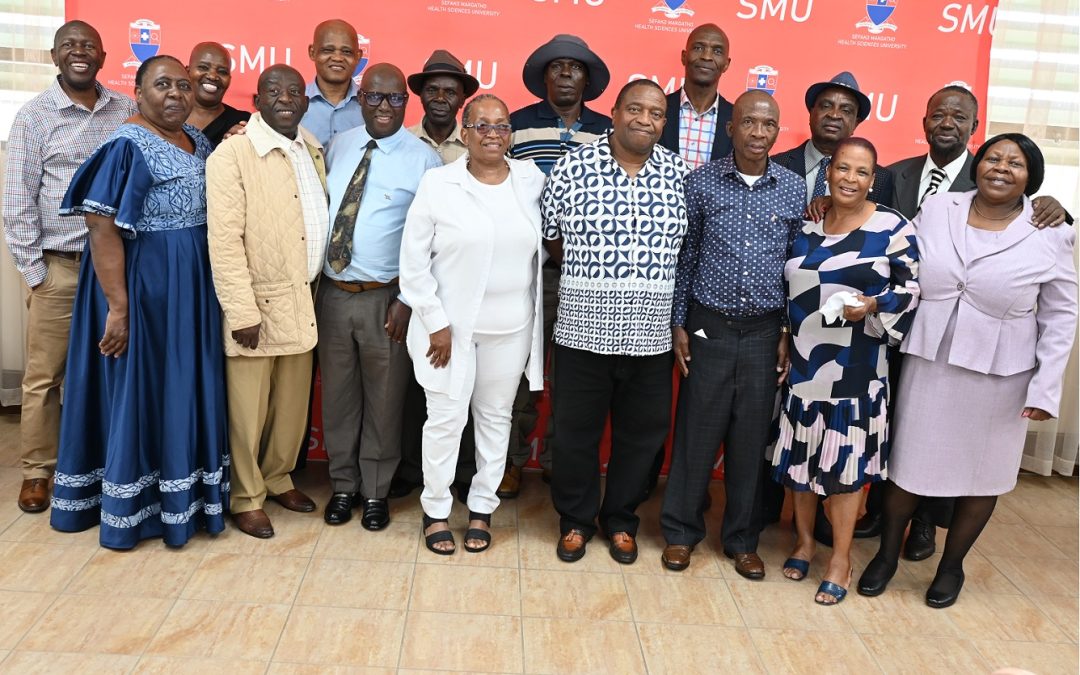
by Lorato | Nov 27, 2025 | All News, SMU Media, Student Media
Sefako Makgatho Health Sciences University (SMU) honoured its long-serving employees at a warm and memorable Retirees’ Appreciation Event held at the Vice-Chancellor’s Dining Hall. The ceremony brought together University leadership, colleagues, and family members to celebrate the contributions of staff whose dedication has strengthened SMU over the years.
 The programme opened with an inspiring welcome address by Acting Senior Director: Human Resources, Lebo Molefe, who expressed deep gratitude to the retirees for their commitment and professionalism. “Our University stands tall today because of people like you,” she said. “Your service has helped shape SMU into a place of excellence and integrity. We honour not only the years you have spent with us, but the passion you brought to your work every single day.”
The programme opened with an inspiring welcome address by Acting Senior Director: Human Resources, Lebo Molefe, who expressed deep gratitude to the retirees for their commitment and professionalism. “Our University stands tall today because of people like you,” she said. “Your service has helped shape SMU into a place of excellence and integrity. We honour not only the years you have spent with us, but the passion you brought to your work every single day.”
Delivering the Vice-Chancellor’s message on behalf of Prof Tandi Matsha-Erasmus, who was unable to attend due to prior commitments, Acting DVC: Operations, Odette Ramsingh, extended heartfelt appreciation to all retirees. Speaking on behalf of the Vice-Chancellor, she remarked, “The legacy you leave behind is woven into the fabric of SMU. Your hard work has strengthened our academic, administrative, and operational excellence, and for that, we are truly grateful.”
Ramsingh encouraged the retirees to remain connected to the University community, adding, “Though this marks the end of your formal service, you will always be part of the SMU family. We value the foundation you have laid and the example you leave for those who follow.”
A highlight of the ceremony was the presentation of certificates to the retirees, led by Mercia Makgati, Deputy Director: HR Operations. She congratulated each retiree individually, acknowledging their contributions with warmth and respect. “Your dedication has carried this institution forward,” Makgati said. “Today we honour not only your years of service, but the impact you made on the lives of colleagues, students, and the broader SMU community.”
 Among the retirees celebrated was Radipoponono Tladi, who retires after 10 years of service as part of SMU’s gardening personnel. Fondly known across campus as “the Honourable One,” Tladi is admired for his quiet humility and gentle spirit. “I loved my work and I loved the people I worked with,” Tladi said softly as colleagues applauded. “Every flower I planted and every space I cleaned, I did with pride because this place became my home.”
Among the retirees celebrated was Radipoponono Tladi, who retires after 10 years of service as part of SMU’s gardening personnel. Fondly known across campus as “the Honourable One,” Tladi is admired for his quiet humility and gentle spirit. “I loved my work and I loved the people I worked with,” Tladi said softly as colleagues applauded. “Every flower I planted and every space I cleaned, I did with pride because this place became my home.”
Tladi leaves behind a legacy of unwavering dedication, kindness, and professionalism. His presence on campus—always calm, warm, and respectful—has left a lasting impact on staff and students alike.
Another standout honouree was Johanna Grobler, who retires after an extraordinary 42 years of service in SMU’s Orthodontics Department. Deeply respected across the institution, Grobler shared emotional reflections on her time at the University. “SMU has been my second home for more than four decades,” she said. “I have watched students grow into clinicians, colleagues become lifelong friends, and this institution transform into what it is today.”
Grobler expressed gratitude for the support she received over the years. “I am leaving with a full heart. It has been an honour to serve, to teach, and to learn alongside so many wonderful people.”
The atmosphere throughout the event was one of celebration, gratitude, and heartfelt connection. Colleagues shared stories and warm tributes, highlighting the unique qualities and exceptional dedication of each retiree.
As the University marked this important moment, it reaffirmed its commitment to recognising the people who have contributed to its growth and success. The retirees leave behind a powerful legacy of service, resilience, and excellence.
SMU extends its deepest appreciation to all retirees for their invaluable service. Their contributions will continue to inspire the next generation, and the University wishes them a fulfilling and rewarding journey ahead.
By Dimakatso Modise
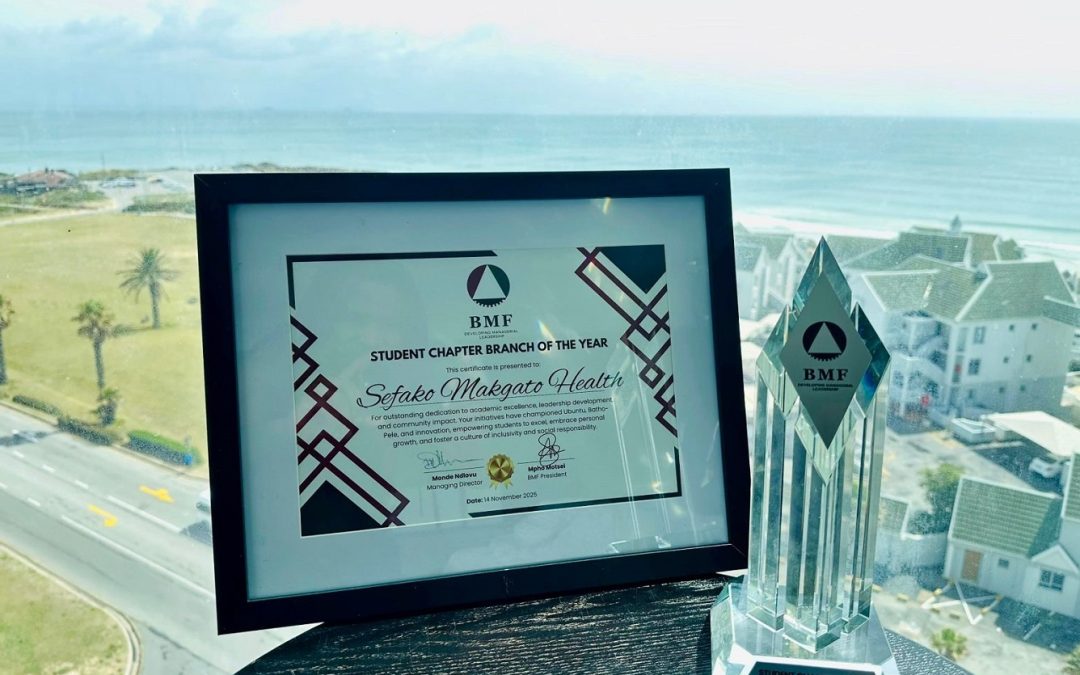
by Lorato | Nov 26, 2025 | Accolades and Achievements, All News, SMU Media, Student Media
The Black Management Forum Student Chapter at Sefako Makgatho Health Sciences University (BMF SC SMU) has been crowned BMF Student Chapter Branch of the Year, earning national recognition for exceptional leadership, bold innovation, and unwavering commitment to student development. The accolade, conferred during the 49th annual general meeting (AGM) held in Gqebherha, Eastern Cape, from 13–14 November 2025, marks a defining moment for the chapter after a year its executive describes as one driven by discipline, collaboration, and measurable impact.
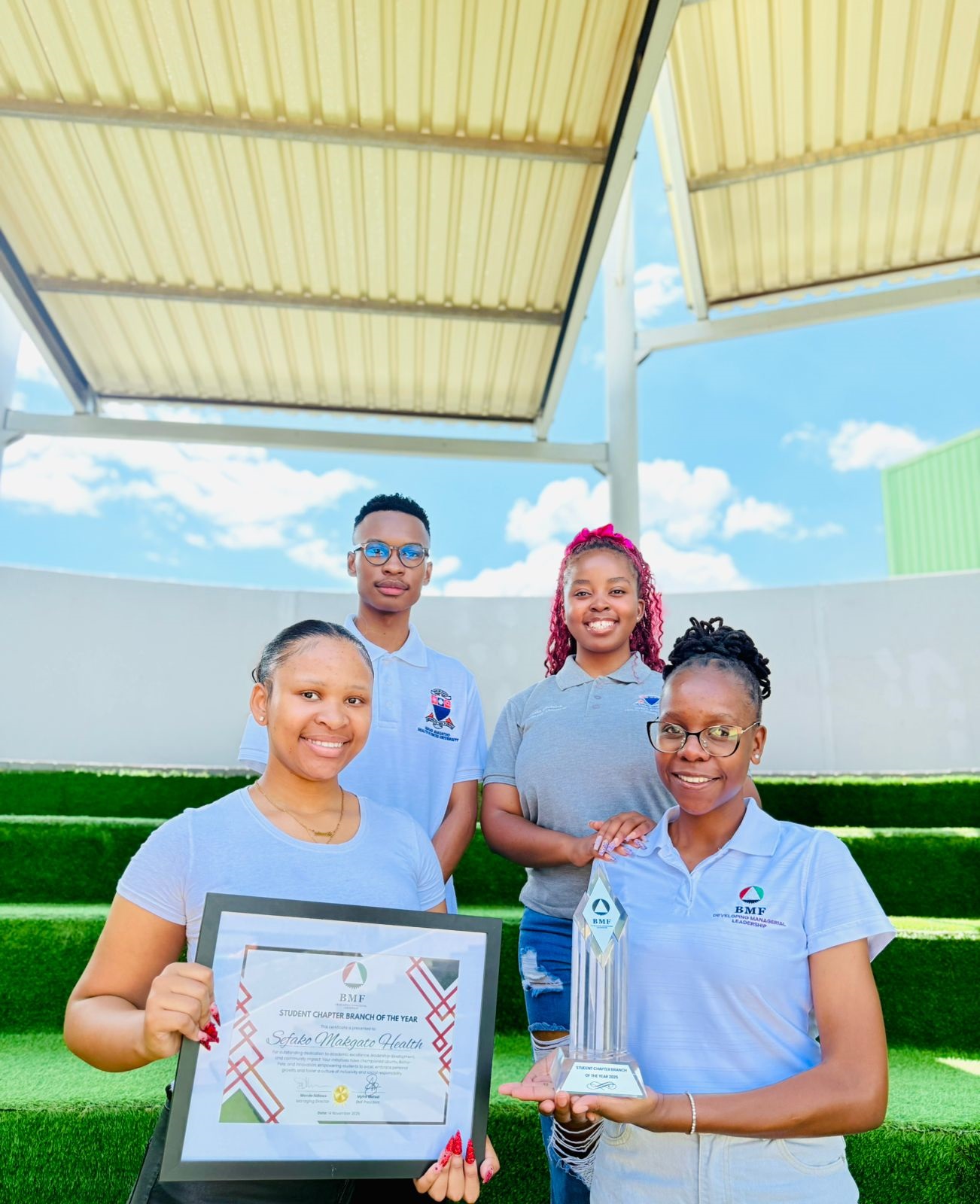 Chairperson Thato Phasha described the win as “a powerful affirmation of what focused, values-driven student leadership can achieve.” She added, “Our goal has always been to empower students with real opportunities for growth. This award proves that commitment pays off.”
Chairperson Thato Phasha described the win as “a powerful affirmation of what focused, values-driven student leadership can achieve.” She added, “Our goal has always been to empower students with real opportunities for growth. This award proves that commitment pays off.”
The accolade is presented to a student chapter that demonstrates exceptional performance across key areas, including academic excellence, youth development, and the promotion of values such as creativity, integrity, and accountability. According to the adjudicators, BMF SC SMU excelled by delivering evidence of meaningful programmes and sustained community engagement.
Secretary Thabiso Kekana highlighted the chapter’s strategic approach, saying: “We worked intentionally—every programme, every partnership, every event had to benefit students directly. Impact was our priority.”
At the core of the chapter’s work is the BMF mandate of “Developing Managerial Leadership,” which empowers young people preparing to enter the corporate and economic sectors. The Student Chapter aims to equip its members with managerial competence and an understanding of socio-economic transformation.
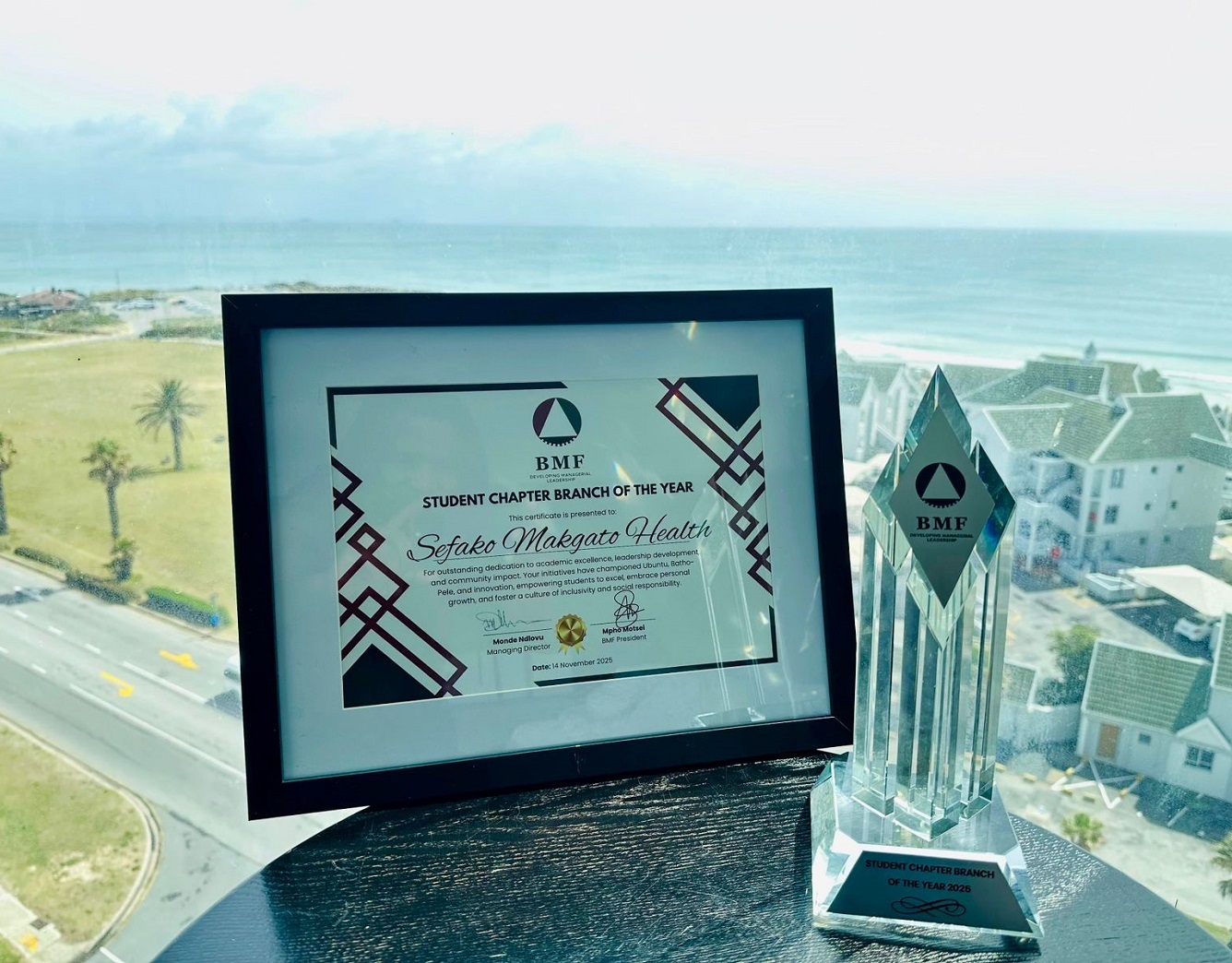 In 2024–2025, BMF SC SMU rolled out a series of high-impact initiatives. The Recruitment Drive strengthened member diversity, ensuring that more students gained access to leadership development platforms. The Mentorship and Tutorship Programme provided personalised academic support, contributing to improved performance and confidence among students.
In 2024–2025, BMF SC SMU rolled out a series of high-impact initiatives. The Recruitment Drive strengthened member diversity, ensuring that more students gained access to leadership development platforms. The Mentorship and Tutorship Programme provided personalised academic support, contributing to improved performance and confidence among students.
Economic empowerment remained a strong pillar of the chapter’s agenda. Entrepreneurship Day encouraged entrepreneurial thinking and innovation, while the Financial Literacy Programme equipped students with practical skills for budgeting, saving, and long-term financial planning. Women’s empowerment took centre stage through Empowered Women, Empowering Economies, an initiative that promoted financial independence and leadership among female students.
Reflecting on these initiatives, Gender and Transformation Officer Maobuseng Mafata noted: “Our programmes are designed to break barriers—academic, financial, and social. We are developing well-rounded leaders.”
Project Officer Confidence Chego added, “This year proved that collaboration is our strongest tool. When students feel supported, they excel.”
The chapter’s achievements were amplified through key partnerships with STANLIB and MoneyCare, which enhanced the professionalism and reach of its programmes. These collaborations, Phasha said, “allowed us to deliver initiatives at a national standard.”
Winning the national title has energised the chapter’s leadership. According to Kekana, the recognition serves as “a commitment to go even further, to create more opportunities, and to raise the bar for student leadership across the country.”
As BMF SC SMU looks ahead, its mission remains unchanged: to shape a generation of ethical, dynamic, and socially conscious leaders. With renewed national recognition and a proven track record, the chapter stands poised for an even more impactful future.
By Tumelo Moila

 His professional odyssey began in earnest in May 1987 when he joined the then Medical University of South Africa (Medunsa) as a Medical Technologist in the Department of Haematological Pathology. Prior to this appointment, he trained extensively in Clinical Pathology, Microbiology, and Immunology—foundational expertise that would define his contributions to medical science over the next four decades. “Joining Medunsa was a dream come true,” he says. “The University gave me opportunities to grow professionally and academically, which I could not have imagined at the time.”
His professional odyssey began in earnest in May 1987 when he joined the then Medical University of South Africa (Medunsa) as a Medical Technologist in the Department of Haematological Pathology. Prior to this appointment, he trained extensively in Clinical Pathology, Microbiology, and Immunology—foundational expertise that would define his contributions to medical science over the next four decades. “Joining Medunsa was a dream come true,” he says. “The University gave me opportunities to grow professionally and academically, which I could not have imagined at the time.” Parallel to his scientific and academic work, Lekabe has been a respected figure in labour leadership. Encouraged by Prof Vanessa Moodley, he actively participated in union matters and was appointed Chairperson of the South African Parastatal and Tertiary Institutions Union (SAPTU) in 2015, a role he continues to fulfil with distinction. “Being a union leader taught me the importance of dialogue, fairness, and collective responsibility,” he reflects.
Parallel to his scientific and academic work, Lekabe has been a respected figure in labour leadership. Encouraged by Prof Vanessa Moodley, he actively participated in union matters and was appointed Chairperson of the South African Parastatal and Tertiary Institutions Union (SAPTU) in 2015, a role he continues to fulfil with distinction. “Being a union leader taught me the importance of dialogue, fairness, and collective responsibility,” he reflects.

 Delivering her opening address, the Vice-Chancellor, Professor Tandi Matsha-Erasmus, emphasised that excellence is a defining trait of SMU’s evolving identity. “Excellence at SMU is not a destination; it is a culture we build together,” she said. “Every staff member honoured tonight represents our commitment to transforming lives through education, research and service. Their contributions are the backbone of the University’s progress and our impact on society.”
Delivering her opening address, the Vice-Chancellor, Professor Tandi Matsha-Erasmus, emphasised that excellence is a defining trait of SMU’s evolving identity. “Excellence at SMU is not a destination; it is a culture we build together,” she said. “Every staff member honoured tonight represents our commitment to transforming lives through education, research and service. Their contributions are the backbone of the University’s progress and our impact on society.” Reflecting on the accolade, Mathole said: “This award is deeply meaningful. Leadership is about service, collaboration and believing in the potential of others. I am grateful to work in an environment where ideas are supported, and innovation is encouraged.” She added that the recognition belongs to her entire team.
Reflecting on the accolade, Mathole said: “This award is deeply meaningful. Leadership is about service, collaboration and believing in the potential of others. I am grateful to work in an environment where ideas are supported, and innovation is encouraged.” She added that the recognition belongs to her entire team.
 A medical doctor, occupational health specialist, academic, business leader, and social innovator, Mabuya has dedicated more than three decades to advancing the wellbeing of South Africans. Her distinguished career aligns strongly with SMU’s mission to cultivate leaders who drive transformation and improve the quality of life across the country.
A medical doctor, occupational health specialist, academic, business leader, and social innovator, Mabuya has dedicated more than three decades to advancing the wellbeing of South Africans. Her distinguished career aligns strongly with SMU’s mission to cultivate leaders who drive transformation and improve the quality of life across the country. As CEO of Qalo DigiHealth, she is advancing healthcare accessibility through digital innovation, promoting the use of electronic health records, remote patient monitoring, and other technologies that make healthcare more effective, affordable, and responsive to patients’ needs.
As CEO of Qalo DigiHealth, she is advancing healthcare accessibility through digital innovation, promoting the use of electronic health records, remote patient monitoring, and other technologies that make healthcare more effective, affordable, and responsive to patients’ needs.
 Dr Naidoo, who opened and led the session, emphasised the need to bridge traditional wisdom with modern scientific innovation. “Our aim was to create a space where Indigenous Knowledge Systems are not only acknowledged, but actively integrated with emerging technologies in ways that benefit health, climate resilience, and community wellbeing,” she said. “This conversation is essential for South Africa’s scientific future, and SMU is proud to help drive it.”
Dr Naidoo, who opened and led the session, emphasised the need to bridge traditional wisdom with modern scientific innovation. “Our aim was to create a space where Indigenous Knowledge Systems are not only acknowledged, but actively integrated with emerging technologies in ways that benefit health, climate resilience, and community wellbeing,” she said. “This conversation is essential for South Africa’s scientific future, and SMU is proud to help drive it.” Reflecting on student involvement, Dr Malebatja stressed the importance of nurturing young scientific talent. “The enthusiasm and creativity of our students show that the next generation is ready to take Indigenous Knowledge research into new spaces,” she said. “Their contributions demonstrated how emerging scholars can influence meaningful and ethical innovation.”
Reflecting on student involvement, Dr Malebatja stressed the importance of nurturing young scientific talent. “The enthusiasm and creativity of our students show that the next generation is ready to take Indigenous Knowledge research into new spaces,” she said. “Their contributions demonstrated how emerging scholars can influence meaningful and ethical innovation.”
 The programme opened with an inspiring welcome address by Acting Senior Director: Human Resources, Lebo Molefe, who expressed deep gratitude to the retirees for their commitment and professionalism. “Our University stands tall today because of people like you,” she said. “Your service has helped shape SMU into a place of excellence and integrity. We honour not only the years you have spent with us, but the passion you brought to your work every single day.”
The programme opened with an inspiring welcome address by Acting Senior Director: Human Resources, Lebo Molefe, who expressed deep gratitude to the retirees for their commitment and professionalism. “Our University stands tall today because of people like you,” she said. “Your service has helped shape SMU into a place of excellence and integrity. We honour not only the years you have spent with us, but the passion you brought to your work every single day.” Among the retirees celebrated was Radipoponono Tladi, who retires after 10 years of service as part of SMU’s gardening personnel. Fondly known across campus as “the Honourable One,” Tladi is admired for his quiet humility and gentle spirit. “I loved my work and I loved the people I worked with,” Tladi said softly as colleagues applauded. “Every flower I planted and every space I cleaned, I did with pride because this place became my home.”
Among the retirees celebrated was Radipoponono Tladi, who retires after 10 years of service as part of SMU’s gardening personnel. Fondly known across campus as “the Honourable One,” Tladi is admired for his quiet humility and gentle spirit. “I loved my work and I loved the people I worked with,” Tladi said softly as colleagues applauded. “Every flower I planted and every space I cleaned, I did with pride because this place became my home.”
 Chairperson Thato Phasha described the win as “a powerful affirmation of what focused, values-driven student leadership can achieve.” She added, “Our goal has always been to empower students with real opportunities for growth. This award proves that commitment pays off.”
Chairperson Thato Phasha described the win as “a powerful affirmation of what focused, values-driven student leadership can achieve.” She added, “Our goal has always been to empower students with real opportunities for growth. This award proves that commitment pays off.” In 2024–2025, BMF SC SMU rolled out a series of high-impact initiatives. The Recruitment Drive strengthened member diversity, ensuring that more students gained access to leadership development platforms. The Mentorship and Tutorship Programme provided personalised academic support, contributing to improved performance and confidence among students.
In 2024–2025, BMF SC SMU rolled out a series of high-impact initiatives. The Recruitment Drive strengthened member diversity, ensuring that more students gained access to leadership development platforms. The Mentorship and Tutorship Programme provided personalised academic support, contributing to improved performance and confidence among students.